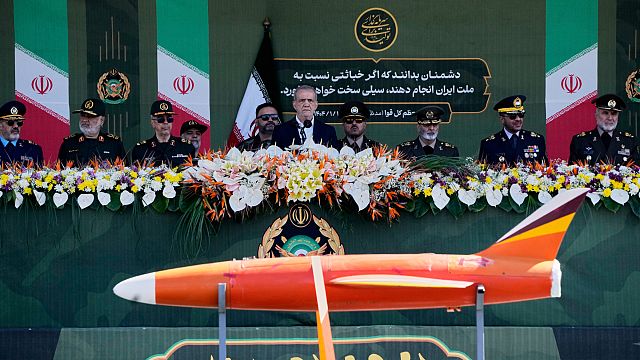Interferometer Device Sees Text from a Mile Away

Interferometer Device Sees Text from a Mile Away



One of astronomers’ tricks for observing distant objects is intensity interferometry, which involves comparing the intensity fluctuations recorded at two separate telescopes. Researchers have now applied this technique to the imaging of remote objects on Earth [1]. They developed a system that uses multiple laser beams to illuminate a distant target and uses a pair of small telescopes to collect the reflected light. The team demonstrated that this intensity interferometer can image millimeter-wide letters at a distance of 1.36 km, a 14-fold improvement in spatial resolution compared with a single telescope.
Interferometry is common in radio astronomy, where the signal amplitudes from a large array of radio telescopes are summed together in a way that depends on the relative phases of the radio waves. Intensity interferometry is something else. It doesn’t involve addition of amplitudes or preservation of phases. Instead, light is recorded from a single source at two separate detectors (or telescopes), and the fluctuations in the intensities of the two signals are compared. Spatial information on the source comes from analyzing how these fluctuations are correlated in time and how this correlation depends on the detector separation.
The correlations can be hard to understand intuitively, and there are both quantum and classical explanations. One quantum description involves two-photon interference. Imagine that photon 1 comes from the left side of the source and arrives at detector A at the same time that photon 2 comes from the right side of the source and arrives at detector B. That scenario is observationally indistinguishable from photon 1 arriving at B and photon 2 arriving at A. The indistinguishability leads to quantum interference that causes a simultaneous fluctuation in intensity at the detectors. This correlation decreases as the separation between detectors is increased.
With a first demonstration in 1956, intensity interferometry has proven useful in measuring star diameters [2]. Still, the technique is less common than amplitude interferometry, as the latter typically offers a stronger signal compared to the noise. But there are “disordered” situations where the light is partially scrambled and amplitude interferometry becomes challenging, says Qiang Zhang from the University of Science and Technology of China. These situations include optical imaging in the presence of atmospheric turbulence and biomedical imaging through tissues.



Until now, intensity interferometry targets have been either bright distant objects (such as stars) or nonluminous objects that can be illuminated by a nearby source. Zhang and his colleagues have now developed an intensity interferometer for remote imaging through the atmosphere. It consists of two telescopes and an infrared laser system installed on the same optical bench. The laser light illuminates the target object, which in the team’s tests was located in another building 1.36 km away.
The main challenge is that laser light is coherent—the photons have related phases—which causes the observed intensity fluctuations to be dominated by the internal variations in the laser (so-called shot noise). To avoid this problem, the team divided their 100-milliwatt laser into eight beams. Each beam travels along a slightly different path through the turbulent atmosphere and thus receives a different random phase perturbation. Counterintuitively, this incoherent illumination makes the interference effects observable.
To demonstrate the system’s capabilities, the team created a series of 8-mm-wide targets, each made from a reflective material and imprinted with a letter. To generate an image, the researchers varied the separation between the two telescopes from 7 to 87 cm. They also incrementally rotated the target by 360°. By detecting the reflected laser light and analyzing the correlations in the intensity fluctuations, the researchers could reconstruct the letter shapes. The observations demonstrated a resolution of 3 mm, whereas one of the telescopes alone would have a resolution of 42 mm—far too poor to make out the letters.
Zhang and his colleagues plan to develop this technology further by improving their control over the laser light. They also plan to incorporate deep learning into the image reconstruction software. Zhang says that a potential application might be space debris detection—the laser light could be shone on nearby orbiting objects.
“The new work represents a significant technical advancement in imaging distant objects that do not emit their own light,” says Shaurya Aarav, a quantum optics researcher from the Sorbonne University in France. He imagines that the remote-imaging system could have several applications, including monitoring insect populations across agricultural land. Optics expert Ilya Starshynov from the University of Glasgow, UK, is impressed with the “clever” system to deliver incoherent light to a distant target. “The fact that they can image millimeter-sized objects at over-kilometer distances is genuinely impressive,” he says.
–Michael Schirber
Michael Schirber is a Corresponding Editor for Physics Magazine based in Lyon, France.
References
- L.-C. Liu et al., “Active optical intensity interferometry,” Phys. Rev. Lett. 134, 180201 (2025).
- R. Hanbury Brown and R. Q. Twiss, “A test of a new type of stellar interferometer on Sirius,” Nature 178 (1956).
Active Optical Intensity Interferometry
Lu-Chuan Liu, Cheng Wu, Wei Li, Yu-Ao Chen, Xiao-Peng Shao, Frank Wilczek, Feihu Xu, Qiang Zhang, and Jian-Wei Pan
Phys. Rev. Lett. 134, 180201 (2025)
Published May 9, 2025
Subject Areas
OpticsRelated Articles
AI Designs Optics Hardware
A machine-learning algorithm rapidly generates designs that can be simpler than those developed by humans. Read More »Optics
Birefringent Nanocubes Give Light a Circular Boost
An achiral metasurface selectively transmits two beams of opposite chirality. Read More »Atomic and Molecular Physics
Gauging the Temperature Sensitivity of a Nuclear Clock
Researchers have characterized the temperature-induced frequency shifts of a thorium-229 nuclear transition—an important step in establishing thorium clocks as next-generation frequency standards. Read More » More Articles
What's Your Reaction?
 Like
0
Like
0
 Dislike
0
Dislike
0
 Love
0
Love
0
 Funny
0
Funny
0
 Angry
0
Angry
0
 Sad
0
Sad
0
 Wow
0
Wow
0







































